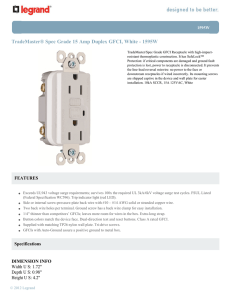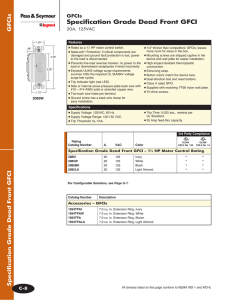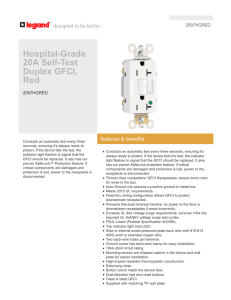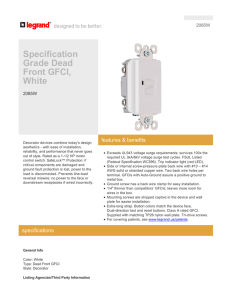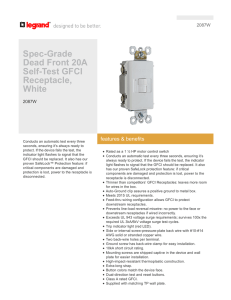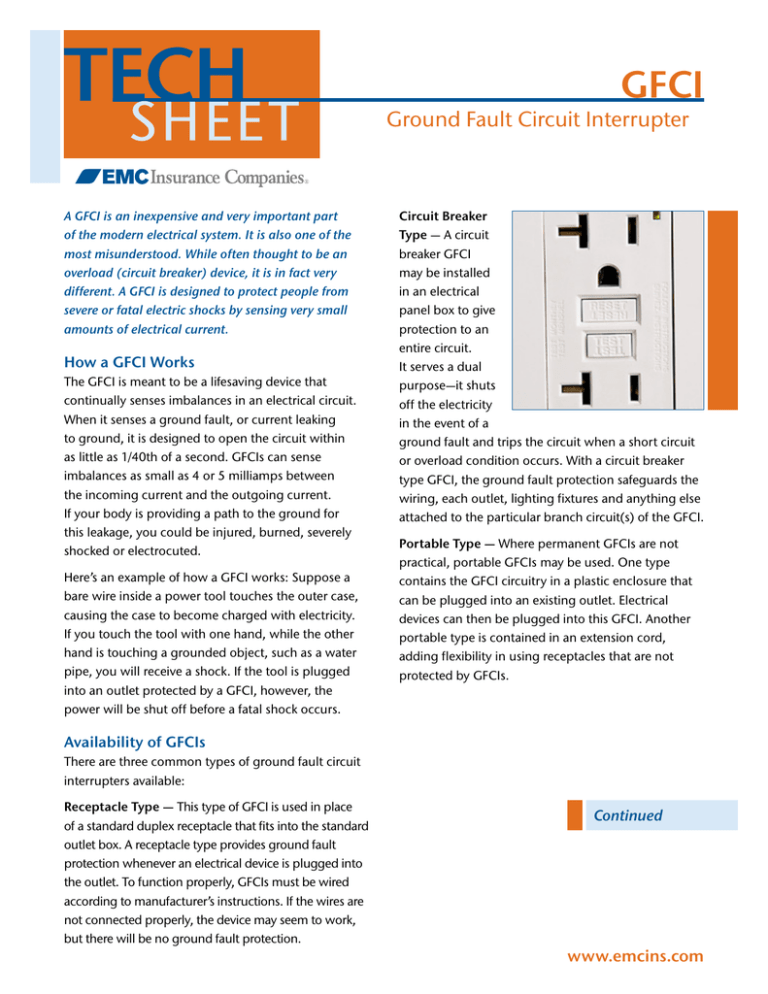
GFCI
Ground Fault Circuit Interrupter
A GFCI is an inexpensive and very important part
of the modern electrical system. It is also one of the
most misunderstood. While often thought to be an
overload (circuit breaker) device, it is in fact very
different. A GFCI is designed to protect people from
severe or fatal electric shocks by sensing very small
amounts of electrical current.
How a GFCI Works
The GFCI is meant to be a lifesaving device that
continually senses imbalances in an electrical circuit.
When it senses a ground fault, or current leaking
to ground, it is designed to open the circuit within
as little as 1/40th of a second. GFCIs can sense
imbalances as small as 4 or 5 milliamps between
the incoming current and the outgoing current.
If your body is providing a path to the ground for
this leakage, you could be injured, burned, severely
shocked or electrocuted.
Here’s an example of how a GFCI works: Suppose a
bare wire inside a power tool touches the outer case,
causing the case to become charged with electricity.
If you touch the tool with one hand, while the other
hand is touching a grounded object, such as a water
pipe, you will receive a shock. If the tool is plugged
into an outlet protected by a GFCI, however, the
power will be shut off before a fatal shock occurs.
Circuit Breaker
Type — A circuit
breaker GFCI
may be installed
in an electrical
panel box to give
protection to an
entire circuit.
It serves a dual
purpose—it shuts
off the electricity
in the event of a
ground fault and trips the circuit when a short circuit
or overload condition occurs. With a circuit breaker
type GFCI, the ground fault protection safeguards the
wiring, each outlet, lighting fixtures and anything else
attached to the particular branch circuit(s) of the GFCI.
Portable Type — Where permanent GFCIs are not
practical, portable GFCIs may be used. One type
contains the GFCI circuitry in a plastic enclosure that
can be plugged into an existing outlet. Electrical
devices can then be plugged into this GFCI. Another
portable type is contained in an extension cord,
adding flexibility in using receptacles that are not
protected by GFCIs.
Availability of GFCIs
There are three common types of ground fault circuit
interrupters available:
Receptacle Type — This type of GFCI is used in place
of a standard duplex receptacle that fits into the standard
outlet box. A receptacle type provides ground fault
protection whenever an electrical device is plugged into
the outlet. To function properly, GFCIs must be wired
according to manufacturer’s instructions. If the wires are
not connected properly, the device may seem to work,
but there will be no ground fault protection.
Continued
www.emcins.com
GFCI
Ground Fault Circuit Interrupter
Where GFCIs Should be Installed
The National Electrical Code® (NEC) requires GFCI
protection to be used for most outdoor residential
receptacles (since 1973), bathroom receptacles (since
1975), garage wall outlets (since 1978), kitchen
receptacles (since 1987), and all receptacles in crawl
spaces and unfinished basements (since 1990).
EMC also recommends that any and all electrical
outlets within 6 feet of any water source (sinks,
pools, hot tubs, etc.) be protected by GFCI.
OSHA requires GFCIs on all 120 volt, 15- and 20-amp
construction site outlets that are not part of the
permanent wiring of the building or structure.
For Additional Information
Occupational Safety & Health Administration:
www.osha.gov
• Ground-Fault Protection on Construction
Sites
Consumer Product Safety Commission:
www.cpsc.gov
• GFCI
National Fire Protection Association:
www.nfpa.org
• GFCI
EMC Tech Sheets: www.emcins.com
Note: GFCIs should be installed by a qualified,
licensed electrician.
Testing GFCIs
All GFCIs should be tested upon installation
and at least once a month to make sure they
are working properly.
To test a GFCI receptacle:
1.
Plug a night-light, lamp or radio into the outlet
and turn on.
2. Press the “TEST” button; the “RESET” button
should pop out and the light should go off.
3. If the “RESET” button pops out but the light does
not go out, the GFCI has been improperly wired.
Contact an electrician to correct the wiring error.
4. If the “RESET” button does not pop out, the GFCI
is defective and should be replaced.
5. If the GFCI is functioning properly and the light
goes out, press the “RESET” button to restore
power to the outlet.
Home Office: 717 Mulberry • Des Moines, IA 50309 • 800-447-2295 • www.emcins.com
Disclaimer: This material is designed and intended for general information purposes only, and is not intended, nor shall be construed or relied upon, as specific legal advice.
©Copyright Employers Mutual Casualty Company 2011. All rights reserved. Image ©2010 JupiterImages Corporation.
6060 (4-11)

